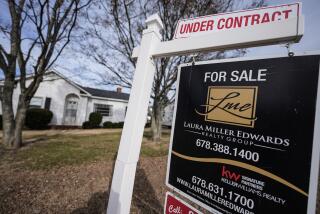Builders’ pricing strategies are aimed at creating sales urgency
- Share via
Reporting from Washington — Even in the toughest times, price hikes are far more common in the new-home business than price cuts.
But the smartest builders are far more sophisticated pricing strategists than you might think.
Savvy builders raise their prices several times before they ever get to a grand opening, which is the event most buyers take as the signal that the builder is ready to start taking orders.
“Price increases don’t start when you have models,” said William Becker, a veteran consultant who has been advising builders and developers for more than 40 years. “They start when you get zoning.”
The first bump occurs when ground is broken for the project. Then builders up the ante when the streets go in, and again when the model homes begin to take shape. Prices go up for a fourth time with the big opening splash.
Builders are equally adept at elevating their prices after the grand opening.
One trick is to limit the number of lots in each phase. Once they’re gone, they’re gone, and the builder moves on to the next phase, even if some parcels in the previous phase have not yet been put on the market. Then, as production proceeds and the builder raises prices in each subsequent section, the unsold lots in previous phases look like bargains when they are finally released.
The idea behind all this, of course, is to create a sense of urgency on the part of potential purchasers.
“We want people to say, ‘What a dummy I was. I could have gotten it at X, and now I have to pay Y. I won’t do that again,’” Becker said.
Some builders raise their prices only two or three times a year. You can almost count on an increase at either the end of the builder’s fiscal year or the end of the calendar year, a strategy designed to boost bottom lines and keep crews working during the slower winter months.
“The biggest changes come in January, which is traditionally a slow month,” said Manny Schatz of Professional Builder Services, a marketing and sales consulting firm in Danville, Calif. “It is after the year-end push and before traffic starts up.”
Large price hikes “create the urgency to sign contracts before the end of the year, and new buyers in February and March are not aware of the big increases,” Schatz said.
If sales are going well, builders sometimes raise their prices every month or so. And if sales are really booming, a boost every Friday before the big weekend onslaught helps maintain the momentum. “Increasing prices on a regular basis motivates prospects to purchase sooner rather than later,” Schatz said.
What if sales are not going so well? Rather than cut prices, he advises his clients to release fewer homes for sale.
S. Robert August of Denver, another marketing and sales consultant in the building business, wants his clients to increase not just the price of the house on a monthly basis but also the cost of options, upgrades and lot premiums.
There also are several other pricing techniques designed to get buyers’ juices flowing. Buyers who are aware of them may be in a better position to negotiate their purchase prices downward:
•Cutting off presales. Sales before a project’s grand opening last no more than four to six weeks. Before preview sales start, a date is set when sales will stop. Agents make sure buyers understand that there is a cutoff period.
•Limiting the number of the least expensive model to no more than 10% of the total number of houses in the subdivision. Because there are always some buyers who want the lowest price (even if they add options), price leaders tend to go quickly.
•Including preferred options. If more than one-third of buyers choose the same option, include it as a standard feature and adjust the base price accordingly. Builders typically charge 15% to 50% above retail for options, depending on how easily buyers can find the product elsewhere. If they include features as standard, they are assured of boosting their margins on every house.
•Offering value packaging. Instead of individual options, package those that are complementary to one another and offer them at a single price. Even if the group price is discounted, profits tend to be greater because the package usually includes some options that the buyer would otherwise forgo.
Distributed by United Feature Syndicate.
More to Read
Inside the business of entertainment
The Wide Shot brings you news, analysis and insights on everything from streaming wars to production — and what it all means for the future.
You may occasionally receive promotional content from the Los Angeles Times.










